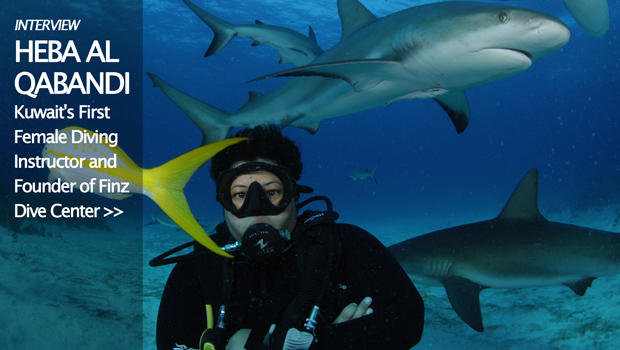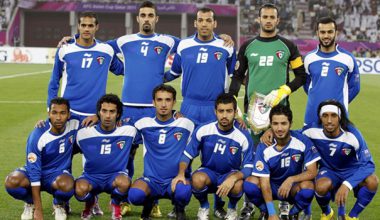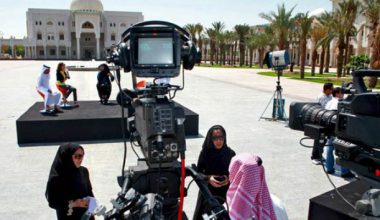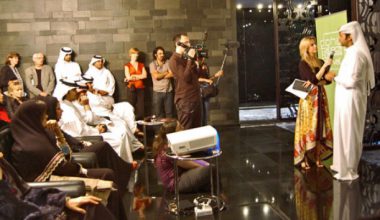
A lot of people run away from Kuwait’s summer heat by traveling. But this year, and in the coming years to follow, why not take up a hobby where the weather actually works for your advantage? Scuba diving is becoming an increasingly popular sport in Kuwait, and in the entire Gulf region and nearby Mediterranean countries.
While this has been the case for many years amongst men, some women shied away from diving because the lessons are typically given by male instructors, not to mention the fact that it has long been mislabeled as a male activity. As it happens, thankfully this is no longer an issue, nor has it been for a good number of years.
Heba Al-Qabandi, founder and owner of Kuwait’s Finz Dive Center, is Kuwati’s first female instructor and has been teaching the sport for a decade now. Al-Qabandi is also an environmental engineer and was kind enough to share her experience on both the sport of scuba diving in Kuwait, as well as some of the reasons behind the unfortunate decline of marine live in the Gulf.
Can you tell us about how you first started scuba diving?
I first started in 2001. I liked it and continued taking all the courses until I reached the Instructor Level License in Kuwait. Then in 2006, I took all the Instructor Trainer and Course Director Licenses in Malaysia.
Why Malaysia?
Taking courses abroad gives you more experience. The final two courses were quite difficult and demanding and because I was in the process of opening a diving school, I wanted the experience.
So when was your school ‘Finz’ officially opened?
In 2006.

Are there many dive schools in Kuwait?
Too many in my opinion. Unfortunately, not many schools give proper training. There are only a handful of schools that make students go through all the necessary training. For example, to certify for an Open Water License, students must dive twice in a swimming pool and twice in the sea. Many schools make do with only having their students dive in a pool. Suppose a person who has only dived in a pool goes diving in the sea without the supervision of an instructor? There is a huge difference between diving in the safety of a pool and diving in the unpredictable sea. Not experiencing this difference for the first time without the supervision of an instructor can be dangerous. This is why both PADI and NAUI (the most respected dive training associations) set these rules in their training manuals, but many instructors ignore them.
Why do you suppose that is?
It’s much cheaper than renting or buying a boat, hiring a captain to steer it, paying for the gas, etc. Diving is not a cheap sport, and yet many schools are lowering the cost to get as many students as possible and the quality of the instruction suffers as a result.
What about the students?
It is only natural that people will go for the cheaper schools. Not many will know that some of these costs are unavoidable to provide a higher quality of instruction. And unless someone takes the time to compare the quality of education in these schools, then how will anyone know? One example is the Rescue Diver course. To be a Rescue Diver, you must take a First Aid course as well. But some schools grant the license without ever giving their students the First Aid course. On one occasion, the student was an acquaintance of one of my dive masters. He said his school said he didn’t need the First Aid course, and he believed them. Imagine his surprise when he was shown the official guidelines of the course, clearly stating that he should have taken First Aid!

So what advice do you have for people who want to take scuba diving courses?
We’ve been talking about dive schools, but in the end the quality of education is up to instructors. They set the quality, not the school. New students should therefore ask about the instructors and choose one that has a reputation for being thorough in training their students, not those who make training easier by skipping difficulties. After all, when not done properly, scuba diving can be dangerous.
How long does a dive course take?
About seven days. At Finz, we usually give it from Sunday to Saturday, or we can accommodate the student’s needs.
What’s the demographic of your students?
Most of them are between 15 to 30 years of age; both men and women. But girls mostly seem interested in scuba diving. At the moment I have a class of six female students.
Do you think being a female instructor gives you an advantage over other schools?
Girls are mostly attracted to scuba. And to teach it, some physical contact is required; so yes many come to me for that reason. Other centers also have female instructors now. But I think they come to me for my experience. I’ve been teaching scuba for ten years.
If I’m not mistaken, you also have the highest qualifications amongst the women instructors?
Yes. I’m a course director. That’s the highest license you can get. But that doesn’t make me better than the other teachers. Only the students can decide that.

Which course do most students take?
The Open Water Course is the first course beginners can take, so that one. And if they enjoy themselves, students usually follow it with the Advanced Open Water course. That’s enough for them to dive recreationally. But some people want to become professionals. They continue all the way to become instructors.
At what age can one start scuba diving?
Ten years is the youngest age allowed.
The classes are in the afternoon?
Yes. My instructors and I all have other jobs. We come to the center every afternoon to give the classes, and take the students out to trips on the weekends.
In your opinion, what are the best diving locations in Kuwait?
The best islands are Garoh and Kubbar. But Kubbar can be dangerous because it’s very crowded and not all boat captains bother watching out for signs that people are diving below. Then there are locations in the sea like Taylor’s Rock. There’s also a nice wreck of a tuck near Arifjan where some fish live.

Are there many fish or corals to see there?
In 2010 there was a great decline in marine life due to the coral reefs being bleached. This phenomenon is a form of natural pollution. The water temperature got so hot (it was 34-35 degrees Celsius) that it actually killed the corals. They turned completely white. The fish left because their habitat was ruined. But it’s getting better now. Last weekend we went diving in Kubbar and saw lionfish as well as a stingray. It was wonderful.
What are some other factors that affect marine life? Also, do you think the increasing number of scuba divers in Kuwait might help solve the problems by raising awareness?

Yes and no. It’s a double edged sword. People gaining an interest in the sport sometimes become more environmentally conscious. But many times scuba divers become part of the problem. The boats that transport divers (and fisherman)to their spots blindly throw their heavy anchors. These anchors hit the corals destroying the fish’s habitats. An anchor breaks 1 sq. meter of coral, and coral only grows 1 cm per year. So coral is being destroyed faster than the rate of its growth. We used to have table coral in Kuwait, but they have all been broken by boat anchors. Also, many divers are not as careful as they should be. They should leave enough space between themselves and the corals so that they do not accidentally bump into the fragile coral. Also, some divers like to collect "souvenirs" from the ocean. Why not leave whatever they find for other people to enjoy? And then they say that there is nothing to see in the Gulf. Some people even like to use their knives to pry open shells to “feed the fish” not knowing that by doing so they are destroying the homes of the very fish they love to see. If you want to feed the fish, just bring along some bread crumbs with you when you go diving. And don’t even get me started on fishermen who don’t abide by fishing seasons and regulations. But most of the harm comes from people who visit the islands, enjoy them, but treat them and the sea as nothing more than their personal garbage can.
So what can one expect to see when they dive in Kuwait?
We have a lot of Arabian angelfish. Then there catfish, parrotfish in Arifjan and Kubbar. We also have barracudas, stingrays and balool. I’ve seen both in Arifjan and Kubbar. Like I said, life is slowly coming back to our Gulf.
What is the best time during the year to go scuba diving?
The season starts in May. May and June are the best times to dive. In July, the weather usually starts to not be as perfect. Then in August, fishermen start "shrimping" so the visibility is not very good because the ground is stirred up.
Is the visibility usually good here?
It varies, but recently, it’s been 10 meters; sometimes even farther.
Finally, where else have you gone scuba diving? Can you recommend any good places abroad?
I’ve gone scuba diving in many places. You have unlimited visibility in Sharm el Sheikh. Lebanon has the fresh water springs, both hot and cold ones. I didn’t like diving in Spain. Malaysia was okay, and in the Bahamas, you can dive with the sharks. But for those who take up the sport, you shouldn't wait until you travel to dive; nor do you need to. Our sea is a gift from God, we should both enjoy and respect it. And diving is such a calming, spiritual hobby. The way you breathe underwater, the energy you spend swimming with the fins; after you finish you are utterly and totally relaxed. It is a completely addictive hobby.
Hearing Heba speak about her passion for diving, one can understand why the Finz school slogan is “Dive is life”. Why not add some excitement to your own life by going scuba diving this summer?
For more information visit www.finz-center.com
– Huda Al Ateeqi
Images courtesy of Finz Dive Center








